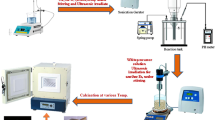Abstract
The purpose of this work was to study the preparation and characterization of drug–hydroxyapatite cement. The hydroxyapatite (HA) cement has been synthesized by using tricalcium phosphate, calcium carbonate and dicalcium phosphate anhydrous with sodium hydrogen phosphate as liquid phase. The effect of added tetracycline hydrochloride (TCH) as drug on final phases, microstructure, setting behaviour and compressive strength has been studied. The drug release rate was first order within the first day and then was zero order. No obvious difference could be detected in XRD patterns of the TCH–HA cement with various amounts of drug. By increasing the drug concentration, mechanical strength of cement was decreased and its setting time was increased. The results of this study demonstrate the potential of using HA cement as a carrier for drug delivery.




Similar content being viewed by others
References
Barralet J E, Grover L M and Gbureck U 2004 J. Biomater. 25 2197
Fernández E, Sarda S and Hamcerencu M 2005 J. Biomater. 26 2289
Ginebra M P, Traykova T and Planell J A 2006 J. Control. Release 113 102
Hench L 1991 J. Am. Ceram. Soc. 74 1487
Ishikawa K, Miyamoto Y, Kon M, Nagayama M and Asaoka K 1995 J. Biomater. 16 527
Josse S et al 2005 J. Biomater. 26 2073
Knabe C, Driessens F C M, Planell J A and Gildenhar R 2000 J. Biomed. Mater. Res. 52 498
Komath M, Varma H K and Ivakumar R 2000 Bull. Mater. Sci. 23 135
Lebugle A, Rodrigues A, Bonnevialle P, Voigt J J, Canal P and Rodriguez F 2002 J. Biomater. 23 3517
Okada Y, Kawanabe K, Fujita H, Nishio K and Nakamura T 1999 J. Biomed. Mater. Res. 47 353
Ooms E M, Wolke J G C and de Heuvel M T U 2003 J. Biomater. 24 989
Peter B et al 2005 Bone 36 52
Rabiee S M, Moztarzadeh F, Solati-Hashjin M and Salimi-Kenari H 2008 Am. Ceram. Soc. Bull. 87 43
Schnieders J, Gbureck U, Thull R and Kissel T 2006 J. Biomater. 27 4239
Sokolova V, Radtke I F, Heumann R and Epple M 2006 J. Biomater. 27 3147
Suchaneck W and Yoshimura M 1998 J. Mater. Res. 13 95
Takagi S, Chow L C and Ishikawa K 1998 J. Biomater. 19 1593
Ueno Y, Futagawa H, Takagi Y, Ueno A and Mizushima Y 2005 J. Control. Release 103 93
Yang Q, Troczynki T and Liu D M 2002 J. Biomater. 23 2751
Author information
Authors and Affiliations
Corresponding author
Rights and permissions
About this article
Cite this article
RABIEE, S.M. Development of hydroxyapatite bone cement for controlled drug release via tetracycline hydrochloride. Bull Mater Sci 36, 171–174 (2013). https://doi.org/10.1007/s12034-013-0424-9
Received:
Revised:
Published:
Issue Date:
DOI: https://doi.org/10.1007/s12034-013-0424-9




